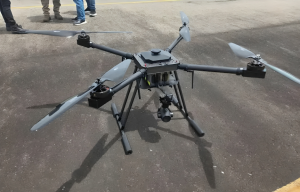Russia reportedly begins SU-35 production for Egypt
- Russian state media reported that the Gagarin aircraft plant in Komsomolsk-on-Amur has launched production of its advanced Su-35 fighter jets under a contract with Egypt.
- The Russian news agency TASS, citing a military diplomatic source, reported that production of SU-35 fighters had been launched, intended to be delivered to the Egyptian Air Force under the contract signed in 2018.
- “The Gagarin aircraft plant in Komsomolsk-on-Amur has launched production of the Su-35, intended to be delivered to the Egyptian Air Force under the contract signed in 2018,” the source said.
- “The deadline for the delivery of the first batch to the Egyptian side has not yet been established, due to restrictions imposed by the new coronavirus outbreak,” he added.
- Russia’s Kommersant newspaper reported in March 2019 that Egypt had decided to buy several Russian-made Su-35 fighter jets for around $ 2 billion. The signing of the agreement has never been confirmed by official sources.
- China became the first foreign country to buy Su-35 when it signed a $ 2.5 billion deal with Russia for 24 planes. The agreement also provided for the supply of spare ground equipment and motors. The delivery of the plane to China was completed in 2019.
- The Su-35S is a highly updated 4 ++ generation superagile multipurpose fighter jet developed on the basis of fifth generation technologies. The Su-35S is distinguished by its new avionics suite based on the information control system, new radar, higher capacity plasma ignition engines and thrust vectoring. These engines meet the requirements for the engine of the fifth-generation fighters, as they allow you to develop supersonic speed without using a downstream burner.
Lockheed Martin awarded $485 million for advanced targeting pods for U.S. and allies
- The U.S. Department of Défense said Monday that Lockheed Martin Corp. won a massive contract for advanced targeting pods.
- The contract, from Air Force Life Cycle Management Center, is valued at more than $485 and covers Sniper, Infrared Search and Track (IRST); and Low Altitude Navigation and Targeting Infrared for Night (LANTIRN) navigation pod (fixed wing) hardware production.
- This contract provides the necessary resources required for the management, fabrication, upgrade/retrofit, integration support and testing and shipping of its non-developmental item (NDI) Sniper Advanced Targeting Pods (ATP) System, NDI LANTIRN Fixed Image Navigation Set upgrades, and the NDI IRST system as it relates to the requirements document associated with each specific delivery order placed under this contract.
- The contract is for Department of Défense and Foreign Military Sales (FMS) include Bahrain, Belgium, Bulgaria, Canada, Egypt, Greece, Indonesia, Iraq, Israel, Jordan, Republic of Korea, Kuwait, Morocco, Netherlands, Norway, Oman, Pakistan, Poland, Qatar, Romania, Saudi Arabia, Slovakia, Taiwan, Thailand and Turkey.
- As a proven provider of IRST technology for more than 30 years, Lockheed Martin has left its mark. To date, the team has delivered more than 350 systems worldwide and consistently advanced its IRST capabilities across a variety of platforms.
Belarus develops unmanned air defence system
- BSVT – New Technologies LLC, a manufacturing company in Belarus, is developing a new unmanned air defence system, called Berserk.
- According to the company, the new one is designed for precision shooting with GShG-7.62 twin machine guns from a halt to enemy personnel and drones, helicopters, and low-flying aircraft.
- Berserk consists of a self-propelled tracking unmanned combat vehicle and an AWS operator that enables remote control and combat operation of the robotic combat vehicle via a wireless communication link at a distance of up to 5000m in case of visibility direct up to 2000 m in an urban area.
- Equipped with a modern optical-electronic system and artificial intelligence elements, it is capable of independently capturing targets at distances of up to 10 km and identifying them by type.
- The high manoeuvrability and cross-country capacity system make it a good solution for the automatic protection of any sector or object through surveillance or patrolling.
Japan unveils next generation assault rifle
- Japan’s Ministry of Défense officially unveiled the newest Howa Type 20 assault rifle, designed to replace the 5.56x45mm Type 89 that was adopted 30 years ago.
- The first time in over 30 years, Japan’s Ground Self-Défense Force (GSDF) members will get new assault weapons.
- The new assault rifles were displayed to the media on May 18 at the Défense Ministry in Tokyo’s Shinjuku Ward.
- The rifle will be indigenously produced in Japan by Howa. Each rifle is expected to cost around 275,000 yen – the equivalent to $2,600. This is calculated from the 2019-20 military budget.
- The Japanese Army currently has around 150,000 active personnel, so the rifle requirement will be substantial.
- GSDF is replacing its members’ rifle for the first time in 31 years since fiscal 1989 and the pistol for the first time in 38 years since fiscal 1982.
- The new rifles were designed to be more resistant to water and corrosion so they could be used in amphibious operations on the remote island chain, which stretches about 1,200 kilometres from the Ohsumi islands in Kagoshima Prefecture to Yonagunijima island in Okinawa Prefecture.
Over 300 terrorists in launch pads across LoC, 240 active in hinterland
- “There are already around four incidents of infiltration in Kashmir valley and two to three such attempts have been made in Rajouri-Poonch area” – Jammu and Kashmir’s Director General of Police (DGP) Dilbag Singh said on Tuesday.
- Expressing concern over it, DGP said that Pakistan’s ISI, Army and other agencies are very active and trained terrorists are ready in launch pads.
Chinese troops resort to aggressive posturing in Ladakh, North Sikkim
- Tension is gradually building up between Indian and Chinese armies in several areas in Ladakh and northern Sikkim along the un-demarcated Sino-India border with both sides bringing in additional troops, days after they were involved in two violent face-offs, authoritative sources said on Tuesday.
- Both the Indian and Chinese armies have brought in more troops in sensitive locations like Demchok, Daulat Beg Oldie and areas around Galwan river as well as Pangong Tso lake in Ladakh, the sources said.
- The area around Galwan has been a point of friction between the two sides for over six decades. They had a showdown over it in 1962 as well.
- The sources said both the sides have deployed their troops around Galwan river and Pangong Tso lake — the two areas where they used to carry out border patrol.
- It is learnt that Chinese side has erected a sizeable number of tents in the Galwan Valley area following which India is keeping a hawk-eye vigil there.
- On May 5, around 250 Indian and Chinese army personnel clashed with iron rods, sticks, and even resorted to stone-pelting in the Pangong Tso lake area in which soldiers on both sides sustained injuries.
- In a separate incident, nearly 150 Indian and Chinese military personnel were engaged in a face-off near Naku La Pass in the Sikkim sector on May 9. At least 10 soldiers from both sides sustained injuries in the incident, according to the sources.
- Neither the Army nor the Ministry of External Affairs commented on the escalating tension between the two armies.
- In its reaction to the two face-offs, the Ministry of External Affairs last week said it remained committed to maintaining peace and tranquillity along the border with China, noting that such incidents could have been avoided if there was a common perception about the frontier.
- It is learnt that additional troops have also been rushed to several areas in northern Sikkim as part of their aggressive posturing in guarding the disputed border.
- A report by China’s official media on Monday said Chinese troops have bolstered their border control measures in the Galwan Valley in the Aksai Chin region.
- The Chinese action followed “India’s recent, illegal construction of defence facilities across the border into Chinese territory in the Galwan Valley region,” a write-up in the state-run Global Times tabloid said, quoting unnamed military sources.
- The aggressive posturing by the two sides came amid India’s escalating border row with Nepal over construction of a strategically key road linking Lipulekh Pass with Dharchula in Uttarakhand.
- Army Chief Gen MM Naravane last week said Nepal objected to the newly-inaugurated road at the behest of “someone else”, in an apparent reference to a possible instigation by China on the matter. Nepal rejected the comments.
- The Lipulekh pass is a far western point near Kalapani, a disputed border area between Nepal and India. Both India and Nepal claim Kalapani as an integral part of their territory.
- It was not clear whether Gen Naravane will visit Nepal soon, following a tradition of the new Indian Army Chief visiting Nepal after taking charge.
- His predecessor Gen Bipin Rawat visited Nepal less than three months after taking charge during which he was conferred the title of honorary general of the Nepalese Army. There is a custom of honouring the army chiefs of Nepal and India by each other keeping with the traditional friendly ties.
- China on Tuesday said the Kalapani issue is between India and Nepal and hoped that the two neighbours would refrain from “unilateral actions” and properly resolve their disputes through friendly consultations.
- The 80-km-long strategically crucial road at a height of 17,000 km along the border with China in Uttarakhand was thrown open by Defence Minister Rajnath Singh on May 8.
- The troops of India and China were engaged in a 73-day stand-off in Doklam tri-junction in 2017 which even triggered fears of a war between the two nuclear-armed neighbours.
- The India-China border dispute covers the 3,488-km-long Line of Actual Control, the de-facto border between the two countries.
- China claims Arunachal Pradesh as part of southern Tibet while India contests it.
- Both sides have been asserting that pending the final resolution of the boundary issue, it is necessary to maintain peace and tranquillity in the border areas.
- China has been critical of India’s reorganisation of J&K and has particularly criticised New Delhi for making Ladakh a union territory. China lays claim over several parts of Ladakh.
- Prime Minister Narendra Modi and Chinese President Xi Jinping held their first informal summit in April 2018 in the Chinese city of Wuhan, months after the Doklam standoff.
- In the summit, the two leaders decided to issue “strategic guidance” to their militaries to strengthen communications so that they can build trust and understanding.
- Modi and Xi held their second informal summit in Mamallapuram near Chennai in October last year with a focus on further broadening bilateral ties.
REVIEW QUESTIONS
- Russia reportedly begins which aircraft production for Egypt?
- Ilyushin IL 82
- SU-35
- Let L-410 Turbolet
- Kamov Ka-226
ANSWER: B
- Japan unveils next generation assault rifle. What is it?
- Type 99 Arisaka rifle
- Howa Type 20 assault rifle
- Howa Type 64 assault rifle
- Type 98 Arisaka rifle
ANSWER: B
- Director General of Police of Jammu and Kashmir:
- Dilbag Singh
- Hitesh Chandra Awasthy
- M. Mahender Reddy
- Shankar Rao
ANSWER: A





















